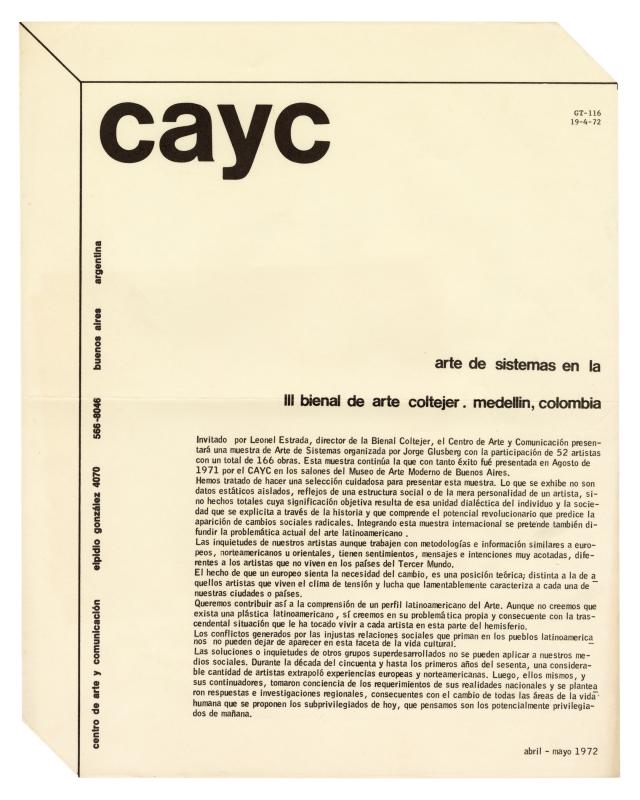Ever since it was founded, the CAYC (Centro de Arte y Comunicación), helmed by the cultural promoter, artist, and businessman Jorge Glusberg, was intended as an interdisciplinary space where an experimental art movement could flourish. The establishment of collaborative networks connecting local and international artists and critics played a key role in this process. The exhibitions shone a light on these exchanges, in which overviews of trends or individual artists introduced the innovations of international contemporary art and made Argentine and Latin American artists better known on the global scene.
At the first Arte de Sistemas exhibition, presented in 1971 at the Museo de Arte Moderno in Buenos Aires, Glusberg defined “arte de sistemas” as an art practice based on an understanding of the systems and processes that are used to organize the contemporary world’s experience. This definition was close to “systems esthetics,” the term coined in 1968 by the North American critic Jack Burnham. Over time, in Argentina, the term was used to refer to several dissimilar trends and movements, such as art as an idea (or Conceptual art), ecological art, poor art (Arte Povera), cybernetic art, proposal arte, and blatantly political art, a local approach driven by the authoritarian regimes and military coups d’états that South America was being forced to endure.
1972 was a pivotal year in the establishment of “arte de sistemas” as the CAYC’s institutional promotional strategy. After opening in May at the III Bienal de Arte Coltejer, in Medellín (Colombia), the exhibition set off on a lengthy journey that took it to a number of Latin American and European cities. This show also set a precedent for the CAYC’s subsequent versions of the show, which all used heliographic prints as supports for the exhibited works, an economical and easily reproducible resource that, in Glusberg’s words, “was not a random choice, but a direct consequence of our inability to compete with technological mediums and operating budgets that we do not yet have.” This new medium’s reproductive potential and low cost made it possible to circulate images more widely and exhibit them in several places at the same time.
Hacia un perfil del arte latinoamericano exhibited the heliographic prints that Argentinean and international artists produced to explore and interpret some of the cultural and political situations that Latin American countries shared at that time. The exhibition presented the Grupo de los Trece’s ideas on “art as ideology” in the form of a brief overview of contemporary art of the region. “Arte de sistemas” no longer simply referred to international process art; its political focus and regional subject matter imbued it with an identity of its own.
[For more information about the CAYC’s conceptual turn, see GT-116 (doc. no. 1476404) and GT-116A (doc. no. pending)].

